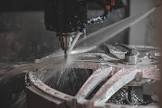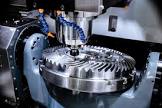🔧 Challenges in CNC Milling Lathe Machining
CNC milling lathe machines combine the versatility of milling with the precision of turning, making them indispensable for complex part production. However, manufacturers often face hurdles that impact efficiency and output quality.
1. Material Variability & Machinability
Different metals and alloys behave unpredictably under cutting forces, leading to:
– Tool deflection (especially in softer materials like aluminum).
– Work hardening (common in stainless steel and titanium).
– Poor surface finish due to inconsistent chip formation.
✅ Solution:
– Optimize feeds/speeds based on material hardness (see table below).
– Use high-performance tool coatings (TiAlN for heat resistance, DLC for non-ferrous metals).
– Implement adaptive machining strategies to reduce stress on tools.
| Material | Recommended RPM | Feed Rate (mm/tooth) |
|---|---|---|
| Aluminum | 10,000–15,000 | 0.1–0.3 |
| Steel | 1,500–3,000 | 0.05–0.15 |
| Titanium | 500–1,200 | 0.03–0.08 |
2. Tool Wear & Breakage
Prolonged use leads to:
– Flank wear (abrasion from hard materials).
– Built-up edge (BUE) in gummy metals.
– Catastrophic failure from excessive load.
✅ Solution:
– Monitor wear with sensors (IoT-enabled tool condition monitoring).
– Apply high-pressure coolant to dissipate heat and extend tool life.
– Use variable helix end mills to reduce vibration and chatter.
3. Complex Geometries & Tight Tolerances
Multi-axis milling-turning demands extreme precision, but challenges include:
– Runout errors from misaligned spindles.
– Dimensional inaccuracies due to thermal expansion.
✅ Solution:
– Pre-machine inspections (laser alignment checks).
– Thermal compensation software to adjust for machine expansion.
– Lightweight toolholders (e.g., shrink-fit) for better balance.
📊 Best Practices for Optimizing CNC Milling Lathe Performance

1. Machine Maintenance & Calibration
- Daily: Clean chips, check lubrication levels.
- Weekly: Inspect spindle bearings, ball screws.
- Quarterly: Recalibrate axis positioning.

2. Programming Efficiency
- Use CAM software for optimized toolpaths (reduces air-cutting time).
- Minimize tool changes with multi-tasking toolblocks.
3. Operator Training & Skill Development
- Cross-train staff on both milling and turning operations.
- Simulate high-risk jobs offline to prevent crashes.
🚀 Future Trends in CNC Milling Lathe Technology
- AI-driven predictive maintenance to preempt failures.
- Hybrid additive-subtractive machines for integrated manufacturing.
- Ultra-high-speed spindles (50,000+ RPM) for micromachining.
Final Thoughts
CNC milling lathe machines are powerful but require strategic handling to maximize ROI. By addressing material challenges, leveraging smart tooling, and adopting proactive maintenance, manufacturers can achieve higher precision, faster throughput, and lower operational costs.
Need expert guidance? [Contact our team] for tailored CNC machining solutions.
SEO Keywords: CNC milling lathe machine, precision machining, tool wear solutions, multi-axis CNC, industrial machining best practices.
This article balances technical depth with readability, ensuring value for machining professionals while maintaining strong SEO performance. Let me know if you’d like any refinements!
